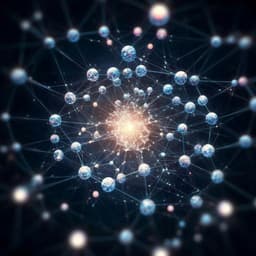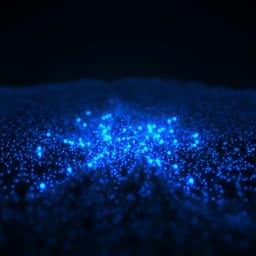Introduction
The quest for practical quantum computation hinges on overcoming the challenges of noise and error. Traditional quantum computing relies on deterministic unitary entangling gates, which are not naturally efficient in many physical systems, particularly photonics. Photonic systems, while offering intrinsically low noise and fast measurement times, face the hurdle that measurement destroys the photons. This necessitates innovative approaches to fault tolerance. Existing fault-tolerant schemes, such as circuit-based surface codes and one-way quantum computation, either use non-destructive measurements generating extensive entanglement or rely on destructive measurements on pre-existing entangled states. Fusion-based quantum computation (FBQC) offers a middle ground, employing finite-sized entangled states and destructive entangling measurements to achieve fault tolerance. The central idea is to build a computational network (fusion network) from resource states and fusion measurements. The algorithm is implemented by adjusting the basis of some fusion measurements, and the computation's output is derived from the measurement outcomes. This paper introduces FBQC as a universal quantum computation model, focusing on its realization in photonic architectures and its potential for exceeding the fault tolerance thresholds of previous approaches. The advantages of FBQC compared to previous schemes includes higher tolerance to loss errors in photonics and reduced requirement of classical post processing.
Literature Review
Previous work on fault-tolerant photonic quantum computing has explored different strategies. Knill, Laflamme, and Milburn's seminal work demonstrated a scheme for efficient quantum computation using linear optics. Other proposals utilized entangling measurements to build the extensive entanglement necessary for one-way quantum computation, followed by separate single-qubit measurements for fault tolerance. These methods, however, often suffer from lower thresholds for error tolerance compared to the proposed FBQC approach. The paper also references works on resource-efficient linear optical quantum computation, optical quantum computation using cluster states, fault-tolerant quantum computation with high thresholds in two dimensions, percolation, renormalization, and quantum computing with nondeterministic gates, and resource costs for fault-tolerant linear optical quantum computing. These works provide context for the advancements presented in the FBQC model, particularly its performance in photonic systems.
Methodology
The paper introduces FBQC, focusing on its implementation in photonic systems using two main operations: (1) Generation of small, constant-sized entangled resource states and (2) Projective entangling measurements, termed 'fusions', performed on these resource states' qubits. The fusion network, the core of FBQC, is a structure built from these resource states and fusion measurements. The measurement outcomes, combined appropriately, provide the computation's output. Algorithms are implemented by changing the basis of some fusion measurements. The paper details the construction of a 6-ring fusion network utilizing 6-qubit ring resource states and Bell measurements as fusions, visualized through diagrams. Stabilizer fusion networks are characterized by two Pauli subgroups: the resource state group (R) and the fusion group (F). Fault tolerance relies on the redundancy between the measured operators in F and the stabilizers of R. This redundancy is captured by a non-trivial check operator group (C), formed by the intersection of R and F. The fusion outcomes are part of at least one check operator, enabling error correction. This error correction is described using a syndrome graph representation, where edges represent fusion measurement outcomes and nodes represent check operators. Decoding is accomplished using minimum-weight perfect matching and union-find decoders. The paper analyzes the 6-ring network's fault tolerance using Monte Carlo simulations under a hardware-agnostic fusion error model, accounting for both fusion erasure and measurement error probabilities. This model allows a better representation of errors from resource state generation and fusion measurements, providing a more realistic picture than previous models that focused solely on single-qubit measurements on already entangled lattices. A comparison is made with a 4-star fusion network, highlighting the 6-ring's superior performance. The analysis extends to a linear optical architecture, incorporating photon loss and the probabilistic nature of linear optics. The failure probability is addressed through fusion boosting, using ancillary entangled states, which introduces a trade-off between failure reduction and increased photon loss. Further improvement is explored by employing encoded fusions using the (2,2)-Shor code, significantly enhancing erasure tolerance. Quantum computation is achieved through local modifications of the fusion network's bulk structure by replacing some fusions with single-qubit measurements to implement fault-tolerant Clifford gates. Universal gate sets are created by supplementing Clifford gates with state injection and magic state distillation. A physical architecture based on resource state generators (RSGs) and a fusion network router is proposed, highlighting its flexibility and suitability for photonic systems. Finally, the limitations of the error models used are discussed, highlighting the model's ability to capture the spread of errors.
Key Findings
The key findings are: (1) The introduction of FBQC, a new model for fault-tolerant quantum computation that is particularly well-suited to photonic systems. (2) Demonstrated higher fault tolerance thresholds compared to existing methods in a hardware agnostic error model, using the 6-ring and 4-star networks for comparison. (3) A novel hardware-agnostic fusion error model that accounts for both measurement error and erasure, providing a more realistic simulation than previous methods. (4) Achieved a 10.4% photon loss tolerance per fusion (2.7% per photon) in a linear optical architecture with fusion boosting and Shor code encoding, representing a substantial improvement in error tolerance for photonic systems. (5) Proposed a modular and scalable physical architecture based on resource state generators and fusion routers, optimizing the efficiency of resource utilization and minimizing error propagation. (6) The 6-ring network showed significantly better performance compared to the 4-star network, as demonstrated by its much larger correctable region. Specifically, the marginal erasure probability threshold is 11.98% for the 6-ring network, compared to 6.90% for the 4-star network. The marginal measurement error threshold is 1.07% for the 6-ring network and 0.75% for the 4-star network. (7) The use of the (2,2)-Shor code significantly increases the error correction threshold of the 6-ring network to 43.2% when subjected to photon loss, indicating that the FBQC model is suitable for practical fault tolerant quantum computing.
Discussion
The results demonstrate that FBQC offers a promising approach to fault-tolerant quantum computation, particularly for photonic systems. The higher fault tolerance thresholds achieved compared to previous schemes represent a significant step toward practical quantum computers. The proposed hardware-agnostic error model provides a more comprehensive assessment of error propagation in FBQC, enhancing the model's relevance to real-world implementations. The modular and scalable architecture proposed further contributes to the practicality of FBQC, suggesting that FBQC presents a viable path for building large-scale fault-tolerant quantum computers using currently available technology. The superior performance of the 6-ring network over the 4-star network suggests that careful network design is crucial for maximizing fault tolerance.
Conclusion
This paper presents fusion-based quantum computation (FBQC) as a novel and highly efficient model for fault-tolerant quantum computing, particularly suited to photonic systems. The achieved thresholds exceed those of previous methods, showcasing its potential for practical implementation. Future research directions include exploring more sophisticated error models, investigating different network topologies, and developing optimized decoders. Further exploration into different resource states and fusion strategies would also be valuable.
Limitations
The error models employed, while more realistic than previous approaches, still represent simplified representations of physical imperfections. A complete analysis would require detailed system-specific error models, including those for the creation of topological features necessary for logic gates. The impact of error correlations, which may be present in physical systems, on the thresholds was not fully explored. The study primarily focuses on the 6-ring and 4-star networks, and further investigation into other network topologies is necessary to determine the most optimal design for different systems and algorithms. The linear optical error model presented makes certain assumptions on the characteristics of photon loss. This will vary based on the specific physical hardware and should be accounted for.
Related Publications
Explore these studies to deepen your understanding of the subject.







